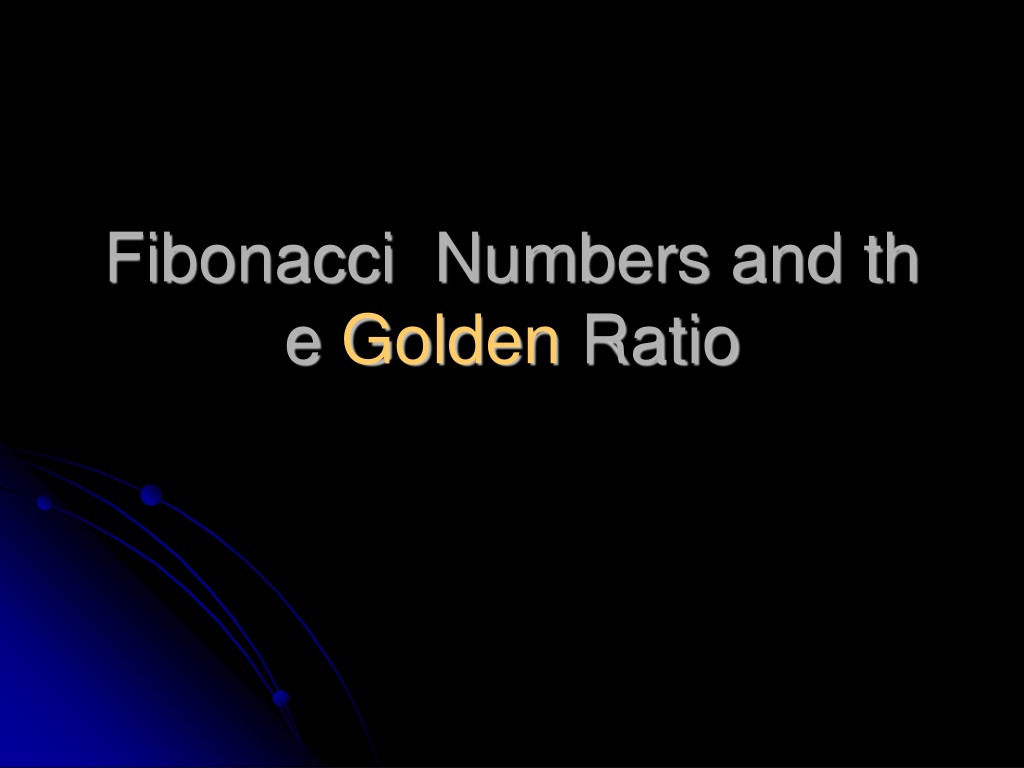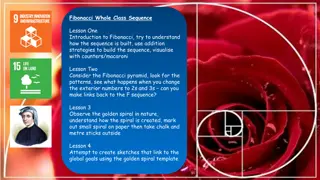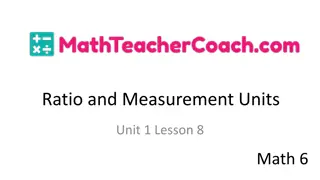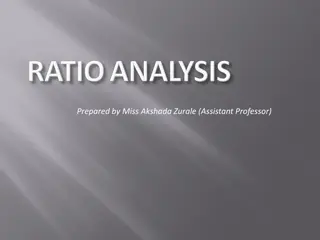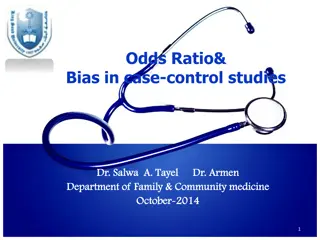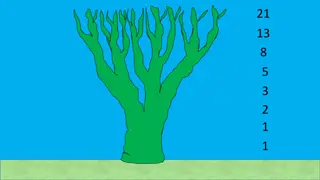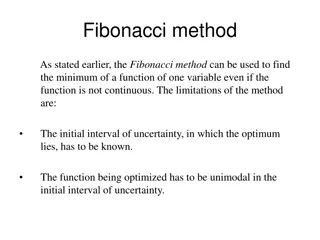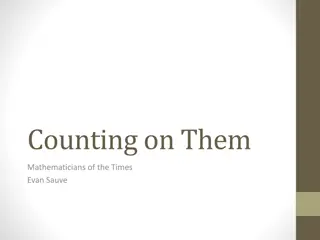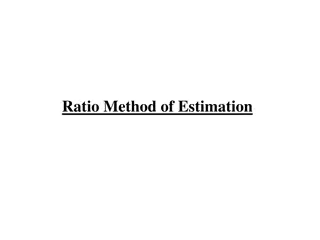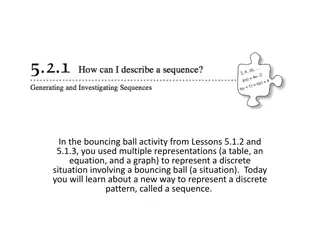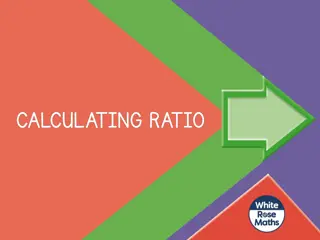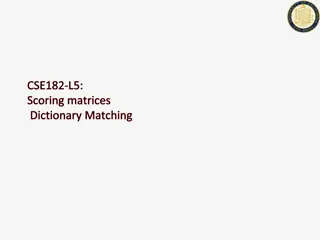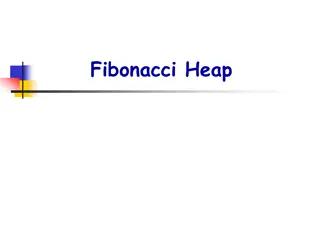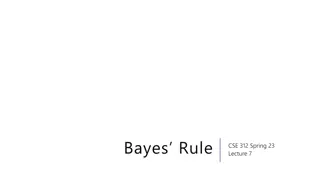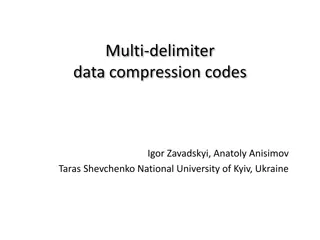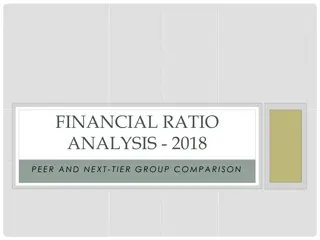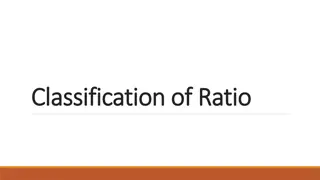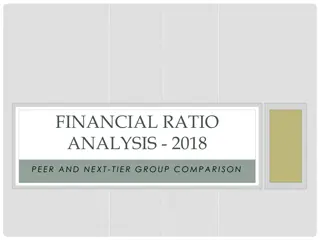Understanding Fibonacci Sequence and the Golden Ratio
Fibonacci numbers are a sequence of numbers starting with 0, 1, where each number is the sum of the two preceding numbers. This sequence, discovered by Leonardo Fibonacci, displays a fascinating relationship to the Golden Ratio when examining the ratios of consecutive numbers. The Golden Ratio, approximately 1.618, is a special number that appears in various aspects of art, architecture, and nature due to its aesthetically pleasing properties.
Download Presentation

Please find below an Image/Link to download the presentation.
The content on the website is provided AS IS for your information and personal use only. It may not be sold, licensed, or shared on other websites without obtaining consent from the author. Download presentation by click this link. If you encounter any issues during the download, it is possible that the publisher has removed the file from their server.
E N D
Presentation Transcript
Fibonacci Numbers and th e Golden Ratio
What is the Golden Ratio? Well, before we answer that question let's ex amine an interesting sequence (or list) of n umbers. Actually the series starts with 0, 1 but to mak e it easier we ll just start with: 1, 1
To get the next number we add the previous two n umbers together. So now our sequence becomes 1, 1, 2. The next number will be 3. What do you thi nk the next number in the sequence will be? Reme mber, we add the previous two numbers to get the next. So the next number should be 2+3, or 5. Her e is what our sequence should look like if we conti nue on in this fashion for a while: 1, 1, 2, 3, 5, 8, 13, 21, 34, 55, 89, 144, 233, 377, 610
Now, I know what you might be thinking: "W hat does this have to do with the Golden Rat io? This sequence of numbers was first discov ered by a man named Leonardo Fibonacci, and hence is known as Fibonacci's sequenc e. Leonardo Fibonacci
The relationship of this sequence to the Gol den Ratio lies not in the actual numbers of th e sequence, but in the ratio of the consecuti ve numbers. Let's look at some of the ratios of these numbers: 1, 1, 2, 3, 5, 8, 13, 21, 34, 55, 89, 144, 233, 377, 610
2/1 = 2.0 3/2 = 1.5 5/3 = 1.67 8/5 = 1.6 13/8 = 1.625 21/13 = 1.615 34/21 = 1.619 55/34 = 1.618 89/55 = 1.618 Since a Ratio is basically a fraction (or a division problem) we will find the rati os of these numbers by dividing the la rger number by the smaller number th at fall consecutively in the series. So, what is the ratio of the 2nd and 3rd numbers? Well, 2 is the 3rd number divided by the 2nd number which is 1 2 divided by 1 = 2 And the ratios continue like this .
2/1 = 2.0 (bigger) 3/2 = 1.5 (smaller) 5/3 = 1.67(bigger) 8/5 = 1.6(smaller) 13/8 = 1.625 (bigger)21/ 13 = 1.615 (smaller) 34/21 = 1.619 (bigger) 55/34 = 1.618(smaller)8 9/55 = 1.618 Aha! Notice that as w e continue down the sequence, the ratios seem to be convergin g upon one number (f rom both sides of the number)! Fibonacci Number calculator
5/3 = 1.67 8/5 = 1.6 13/8 = 1.625 21/13 = 1.615 34/21 = 1.619 55/34 = 1.618 89/55 = 1.618 Notice that I have rounded my ratios to the third decimal pl ace. If we examine 55/34 and 89/55 more closely, we will s ee that their decimal values are actually not the same. But what do you think will happen if we continue to look at the r atios as the numbers in the sequence get larger and larger ? That's right: the ratio will eventually become the same nu mber, and that number is the Golden Ratio!
The Golden Ratio is what we call an irr ational number: it has an infinite numbe r of decimal places and it never repeats itself! Generally, we round the Go lden Ratio to 1.618.
We work with another important irra tional number in Geometry: pi, whic h is approximately 3.14. Since we d on't want to make the Golden Ratio feel left out, we will give it its own G reek letter: phi. Phi
One more interesting thing about Phi is its reciproc al. If you take the ratio of any number in the Fibona cci sequence to the next number (this is the revers e of what we did before), the ratio will approach th e approximation 0.618. This is the reciprocal of Phi : 1 / 1.618 = 0.618. It is highly unusual for the deci mal integers of a number and its reciprocal to be e xactly the same. In fact, I cannot name another nu mber that has this property! This only adds to the mystique of the Golden Ratio and leads us to ask: What makes it so special?
Further classic subdivisions of the rectangle align p erfectly with major architectural features of the struc ture. Further classic subdivisions of the rectangle align perfectly with major architectural features of the structure.
The Golden Ratio in Art Now let's go back and try to discov er the Golden Ratio in art. We will c oncentrate on the works of Leonard o da Vinci, as he was not only a gre at artist but also a genius when it c ame to mathematics and invention.
The Mona Lisa - Measure the length and th e width of the painting itself. The ratio is, of c ourse, Golden. Draw a rectangle around Mo na's face (from the top of the forehead to the base of the chin, and from left cheek to right cheek) and notice that this, too, is a Golden rectangle.
Leonardo da Vinci's talent as an artist may well ha ve been outweighed by his talents as a mathemati cian. He incorporated geometry into many of his p aintings, with the Golden Ratio being just one of hi s many mathematical tools. Why do you think he u sed it so much? Experts agree that he probably th ought that Golden measurements made his paintin gs more attractive. Maybe he was just a little too o bsessed with perfection. However, he was not the only one to use Golden properties in his work.
Constructing A Golden Rectangle Isn't it strange that the Golden Ratio came up in such unex pected places? Well let's see if we can find out why. The Gr eeks were the first to call phi the Golden Ratio. They associ ated the number with perfection. It seems to be part of hum an nature or instinct for us to find things that contain the Go lden Ratio naturally attractive - such as the "perfect" rectan gle. Realizing this, designers have tried to incorporate the Golden Ratio into their designs so as to make them more pl easing to the eye. Doors, notebook paper, textbooks, etc. a ll seem more attractive if their sides have a ratio close to ph i. Now, let's see if we can construct our own "perfect" recta ngle.
Method One 1. We'll start by making a square, any square (just remember that all sides have to have the same length, and all angles have to measure 90 degrees!): 2.Now, let's divide the square in half (bisect it). Be sure to use your protractor to divide the base and to form another 90 degree angle:
Now, draw in one of the diagonals of one of the rectangles Measure the length of the diagonal and make a note of it.
Now extend the base of the square from the midpoin t of the base by a distance equal to the length of the d iagonal
Construct a new line perpendicular to the base at the end of o ur new line, and then connect to form a rectangle: Measure the length and the width of your rectangle. Now, find the ratio of the length to the width. Are you surprised by the result? The rectangle you have made is called a Golde n Rectangle because it is "perfectly" proportional.
Constructing a Golden Rectangle - Method Two Now, let's try a different method that will relate the rectangl e to the Fibonacci series we looked at. We'll start with a sq uare. The size does not matter, as long as all sides are con gruent. We'll use a small square to conserve space, becaus e we are going to build our golden rectangle around this sq uare. Please note that the golden area is what your rectang le will eventually look like.
Now, let's build another, congruent square right next to the first one: Now we have a rectangle with a width 1 and length 2 units. Let's build a square on top of this rectangle, so that the new square will have a side of 2 units: Notice that we have a new rectangle with width 2 and lengt h 3.
Let's continue the process, building another square on the r ight of our rectangle. This square will have a side of 3: Now we have a rectangle of width 3 and length 5.
Again, let's build upon this rectangl e and construct a square underneat h, with a side of 5:
The new rectangle has a width of 5 and a length of 8. Let's continue to t he left with a square with side 8:
Have you noticed the pattern yet? The new rectangle has a width of 8 and a length of 13. Let's continue w ith one final square on top, with a si de of 13:
Our final rectangle has a width of 13 and a length of 21. No tice that we have constructed our golden rectangle using sq uare that had successive side lengths from the Fibonacci s equence (1, 1, 2, 3, 5, 8, 13, ...)! No wonder our rectangle i s golden! Each successive rectangle that we constructed h ad a width and length that were consecutive terms in the Fi bonacci sequence. So if we divide the length by the width, we will arrive at the Golden Ratio! Of course, our rectangle is not "perfectly" golden. We could keep the process going until the sides approximated the ratio better, but for our pur poses a length of 21 and a width of 13 are sufficient.
34 21 Do the Math!! 34 divided by 21 =1.61904761904 Remember that the farther into the sequence we go the closer the ratio gets to being perfect!
Constructing a Golden Spiral Notice how we built our rectangle in a counterclockwise direction. This l eads us into another interesting ch aracteristic of the Golden Ratio. Let 's look at the rectangle with all of ou r construction lines drawn in:
We are going to concentrate on the squares that we drew, starting with the two smallest ones. Let's start with the one on the right. Connect the upper right corner to the lower left corner with an arc that is one fourth of a circle
We are going to concentrate on the squares that w e drew, starting with the two smallest ones. Let's st art with the one on the right. Connect the upper rig ht corner to the lower left corner with an arc that is one fourth of a circle: Then continue your line into the second square on the left, again with an arc that is one fourth of a cir cle: We will continue this process until each square ha s an arc inside of it, with all of them connected as a continuous line. The line should look like a spiral when we are done. Here is an example of what yo ur spiral should look like:
Now what was the point of that? Th e point is that this "golden spiral" oc curs frequently in nature. If you loo k closely enough, you might find a golden spiral in the head of a daisy, in a pinecone, in sunflowers, or in a nautilus shell that you might find on a beach or even in your ear! Here a re some examples:
So, why do shapes that exhibit the Golden Ratio seem more appealing to the human eye? No one really kn ows for sure. But we do have evide nce that the Golden Ratio seems to be Nature's perfect number.
Somebody with a lot of time on their hands discovered that the individual florets of the daisy (and of a sunflower as well ) grow in two spirals extending out from the center. The first spiral has 21 arms, while the other has 34. Do these numb ers sound familiar?
Sunflower head displaying florets in spirals of 34 and 55 around the outside
They should - they are Fibonacci n umbers! And their ratio, of course, i s the Golden Ratio.
We can say the same thing about the spirals of a pinecone, where spirals from the center have 5 and 8 arms, respectively (or of 8 and 13, depending on the size)- again, two Fibon acci numbers:
